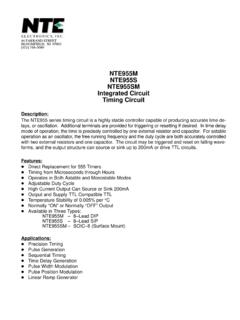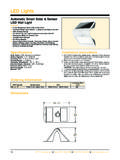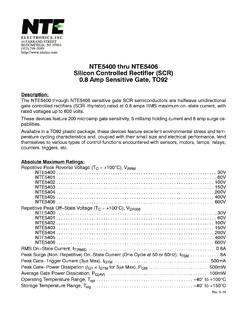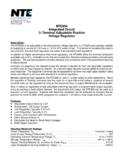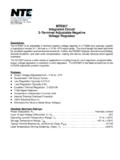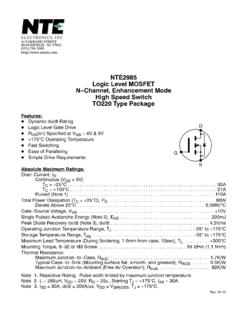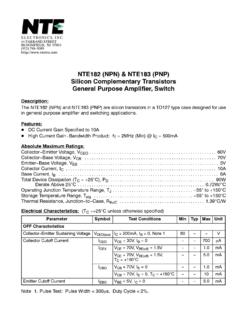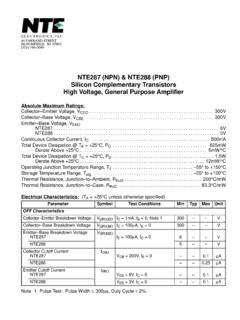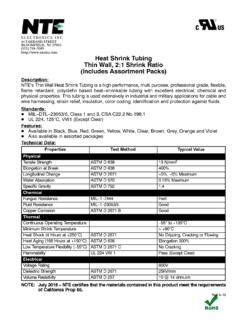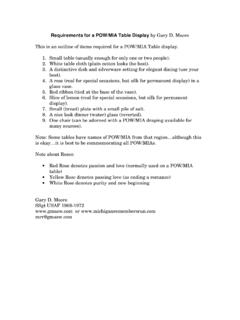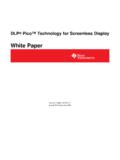Transcription of NTE1509 Integrated Circuit 10–Step Dot/Bar …
1 NTE1509 . Integrated Circuit 10 step Dot/Bar display Driver for logarithmic scale Description: The NTE1509 is a monolithic Integrated Circuit in an 18 Lead DIP type package that senses analog voltage levels and drives 10 LEDs, LCDs, or vacuum fluorescent displays, providing a logarithmic 3dB. analog display . A single pin changes the display from a bar graph to a moving dot display . LED current is regulated and programmable, eliminating the need for current limiting resistors. The whole display system can operate from a single supply as low as 3V or as high as 25V. The Circuit contains its own adjustable reference and accurate 10 step voltage divider.
2 The high im- pedance input buffer accepts signals down to GND and up to within of the positive supply. Fur- ther, it needs no protection against inputs of 35V. The input buffer drives 10 individual comparators referenced to the precision divider. Accuracy is typically better than 1dB. The NTE1509 's 3dB/ step display is suited for signals with wide dynamic range, such as audio level, power, light intensity, or vibration. Audio applications include average or peak level indicators, power meters, and RF signal strength meters. Replacing conventional meters with an LED bar graph results in a faster responding, more rugged display with high visibility that retains the ease of interpretation of an analog display .
3 The NTE1509 is extremely easy to apply. A full scale meter requires only 1 resistor in addition to the 10 display LEDs. One more resistor programs the full scale anywhere from to 12V inde- pendent of supply voltage. LED brightness is easily controlled with a single pot. The NTE1509 is very versitile. The outputs can drive LCDs, vacuum fluorescents, and incandescent bulbs as well as LEDs of any color. Multiple devices can be cascaded for a dot or bar mode display with a range of 60 or 90dB. NTE1509s can also be cascaded with NTE1508s for a linear/log display or with NTE1549s for an extended range VU meter. Features: D 3dB/ step , 30dB Range D Output current programmable from 1 to 30mA.
4 D Drives LEDs, LCDs or vacuum fluorescents D Input withstands 35V without damage or false D Bar or dot display mode externally selectable outputs by user D Outputs are current regulated, open collectors D Expandable to displays of 90dB. D Internal voltage reference from to 12V D Directly Drives TTL or CMOS. D Operates with single supply of 3V to 25V D The internal 10 step divider is floating and can D Inputs operate down to GND be referenced to a wide range of voltages Absolute Maximum Ratings: Power Dissipation (Note 1) .. 1365mW. Supply Voltage .. 25V. Voltage on Output drivers .. 25V. Input Signal Overvoltage (Note 2) .. 35V. Divider Voltage .. 100mV to V+.
5 Reference Load Current .. 10mA. Storage Temperature Range .. 55 to +150 C. Lead Temperature (During soldering, 10sec) .. +260 C. Note 1. The maximum junction temperature of the NTE1509 is +100 C. Device must be derated for operation at elevated temperatures. Junction to ambient thermal resistance is 55 C/W. Note 2. Pin5 input current must be limited to 3mA. The addition of a 39k resistor in series with Pin5 allows 100V signals without damage. Electrical Characteristics: (Note 2, unless otherwise specified, all specifications apply with the following conditions: 3 VDC V+ 20 VDC VREF, VRHI, VRLO (V+ ). 3 VDC VLED V+ 0V VIN V+ VRLO 12 VDC TA +25 C, IL(REF) = , VRHI 12 VDC Pin9 connected to Pin3 (Bar Mode).)
6 Parameter Test Conditions Min Typ Max Unit Comparator Offset Voltage, Buffer, and First Comparator 0V VRLO = VRHI 12V, ILED = 1mA 3 10 mV. Offset Voltage, Buffer, and Any Other 0V VRLO = VRHI 12V, ILED = 1mA 3 15 mV. Comparator Gain ( ILED/ VIN) IL(REF) = 2mA, ILED = 10mA 3 8 mA/mV. Input Bias Current (At Pin5) 0V VIN V+ = 25 100 nA. Input Signal Overdrive No Change is display 35 +35 V. Voltage Divider Divider Resistance Total, Pin6 to Pin4 16 28 36 k . Relative Accuracy (Input Change Between Note 3 dB. Any Two Threshold Points). Absolute Accuracy at Each Threshold Point VIN = 3, 6dB, Note 3 + dB. VIN = 9dB, Note 3 + dB. VIN = 12, 15, 18dB, Note 3 + dB.
7 VIN = 21, 24, 27dB, Note 3 + dB. Voltage Reference Output Voltage IL(REF) 4mA, V+ = VLED = 5V V. Line Regulation 3V V+ 18V %/V. Load Regulation IL(REF) 4mA, V+ = VLED = 5V %. Output Voltage Change with Temperature 0 TA +70 C, IL(REF) = 1mA, V+ = 5V 1 %. Adjust Pin Current 75 120 A. Note 2. Pin5 input current must be limited to 3mA. The addition of a 39k resistor in series with Pin5 allows 100V signals without damage. Note 3. Accuracy is measured referred to + at Pin5, with + at Pin6, and at Pin4. At lower full scale voltages, buffer and comparator offset voltage may add significant error. See table for threshold voltages. Electrical Characteristics (Cont'd): (Note 2, unless otherwise specified, all specifications apply with the following conditions: 3 VDC V+ 20 VDC VREF, VRHI, VRLO (V+ ).)
8 3 VDC VLED V+ 0V VIN V+ VRLO 12 VDC TA +25 C, IL(REF) = , VRHI 12 VDC VLED = 3V, Pin9 connected to Pin3. (Bar Mode). Parameter Test Conditions Min Typ Max Unit Output drivers LED Current V+ = VLED = 5V, IL(REF) = 1mA 7 10 13 mA. LED Current Difference (Between Largest VLED = 5V ILED = 2mA mA. and Smallest LED Currents). ILED = 20mA mA. LED Current Regulation 2V VLED 17V ILED = 2mA mA. ILED = 20mA 1 3 mA. Dropout Voltage ILED(ON) = 20mA, VLED = 5V, V. ILED = 2mA. Saturation Voltage ILED = 2mA, IL(REF) = V. Output Leakage, Each Collector Bar Mode, Note 4 10 A. Output Leakage Dot Mode, Note 4 Pin10 to Pin18 10 A. Pin1 60 150 450 A. Supply Current Standby Supply Current (All Outputs OFF) V+ = 5V, IL(REF) = A.
9 V+ = 20V, IL(REF) = 1mA A. Note 2. Pin5 input current must be limited to 3mA. The addition of a 39k resistor in series with Pin5 allows 100V signals without damage. Note 4. Bar mode results when Pin9 is within 20mV of V+. Dot mode results when Pin9 is pulled at least 200mV below V+ or left open Circuit . LED No. 10 (Pin10 output current) is disabled if Pin9 is pulled or more below VLED. Threshold Voltage: (Note 3). Output dB Min Typ Max Output dB Min Typ Max 1 27 6 12 1 24 7 9 3 21 8 6 4 18 9 3 5 15 10 0 Note 3. Accuracy is measured referred to + at Pin5, with + at Pin6, and at Pin4. At lower full scale voltages, buffer and comparator offset voltage may add significant error.
10 See table for threshold voltages. Pin Connection Diagram LED1 1 18 LED2. V ( ) 2 17 LED3. V (+) 3 16 LED4. Divider Low 4 15 LED5. Signal Input 5 14 LED6. Divider High 6 13 LED7. Reference Output 7 12 LED8. Reference Adjust 8 11 LED9. Mode 9 10 LED10. 18 10. 1 9..870 ( ) Max .250. ( )..150. ( )..100 ( ) .125 ( ) Min .800 ( ).
